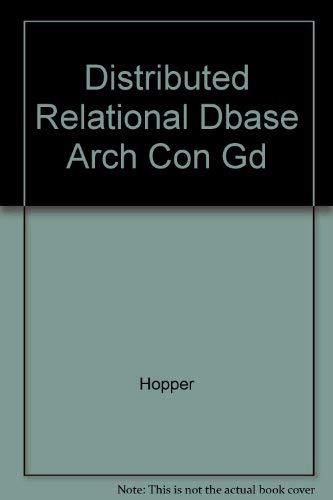Question
Step 1: Mapping of Regular Entity Types For each regular entity type E, create a relation R that includes all the simple attributes of E

Step 1: Mapping of Regular Entity Types
For each regular entity type E, create a relation R that includes all the simple attributes of E
Take simple component attributes of Composite Attributes
Called entity relations
Each tuple represents an entity instance
Choose one of the candidate keys as a PK
Step 2: Mapping of Weak Entity Types
For each weak entity type W, create a relation R
Include all simple attributes of the entity type as attributes of R
Include simple components of composite attributes.
Include primary key attribute of owner as foreign key attributes of R. With weak entities types we can choose cascade for a FK action.
Step 3: Mapping of Binary 1:1 Relationship Types
For each binary 1:1 relationship type S and T
Identify relations that correspond to entity types participating in R
Possible approaches:
Foreign key approach ( First Choice )
Merged relationship approach
Cross-reference or relationship relation approach
Step 3: Mapping of Binary 1:1 Relationship Types S and T Entities
Foreign Key Approach
Choose either S or T to include a FK to the primary key of the other.
Typically you should choose the relation that is in total participation for the relationship.
Any Relationship type attributes should be moved to the relation with the foreign key.
Step 3: Mapping of Binary 1:1 Relationship Types S and T Entities
Merged Relation Approach
Merge S and T into one relation.
Should only be done if both participants are in a total participation relationship with the other. ( This would mean they would both always have the same number of rows )
Step 3: Mapping of Binary 1:1 Relationship Types S and T Entities
Cross Reference or relationship relation approach
Create new relation R as cross reference or lookup table relation
A FK to the PK of S, and a FK to the PK of R will be added to R.
Any relationship attributes will be added to R.
One of the FK will be Rs primary key, and the other will be a unique index.
Step 4: Mapping of Binary 1:N Relationship Types
There are 2 possible approaches
Foreign Key approach
Cross-Reference or relationship relation approach
Step 4: Mapping of Binary 1:N Relationship Types Foreign Key Approach
For each regular binary 1:N relationship type
Identify relation that represents participating entity type at N-side of relationship type, well refer to as S
Include primary key of other entity type as foreign key in S
Include simple attributes of 1:N relationship type as attributes of S
Use the relationship relation (cross-reference) option as in the third option for binary 1:1 relationships
Create relation R
Create Attributes for R that are the PKs of the relations S and T. Make them foreign keys.
Make the N side relation S, the Primary Key in R.
Useful, if not many of the S-side relation participate in the relationship.
Step 5: Mapping of Binary M:N Relationship Types
For each binary M:N relationship type
Create a new relation S
Include primary key of participating entity types as foreign key attributes in S
Include any simple attributes of M:N relationship type
Cascade can probably be used on both foreign keys
Step 6: Mapping of Multivalued Attributes
For each multivalued attribute
Create a new relation, R
Primary key of R is the combination of A, ( the multivalued attribute) and K
If the multivalued attribute is composite, include its simple components
FK can be a cascade operation.
Step 7: Mapping of N-ary Relationship Types
For each n-ary relationship type R
Create a new relation S to represent R
Include primary keys of participating entity types as foreign keys
Include any simple attributes as attributes
FKs can be Cascade delete
7. Use the algorithm we used in Chapter 9 to convert the following ER diagram into relational DB design. Work through the steps of the algorithm to create a solution Author Chapters Genre Book N Written By 1- Author Name Date Reviewed By First Last Rating Reviewer Name
Step by Step Solution
There are 3 Steps involved in it
Step: 1

Get Instant Access to Expert-Tailored Solutions
See step-by-step solutions with expert insights and AI powered tools for academic success
Step: 2

Step: 3

Ace Your Homework with AI
Get the answers you need in no time with our AI-driven, step-by-step assistance
Get Started


